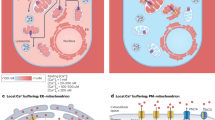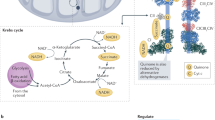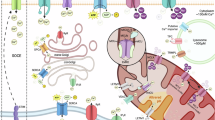Abstract
Despite advanced knowledge on the genetic basis of oxidative phosphorylation-related diseases, the molecular and/or cellular determinants for tissue-specific dysfunction are not completely understood. Here, we report the cellular events associated with mitochondrial respiratory Complex II deficiency occurring before cell death. Mutation or chronic inhibition of Complex II determined a large increase of basal and agonist-evoked Ca2+ signals in the cytosol and the mitochondria, in parallel with mitochondrial dysfunction characterized by membrane potential (Δψmit) loss, [ATP] reduction and increased reactive oxygen species production. Cytosolic and mitochondrial Ca2+ overload are linked to increased endoplasmic reticulum (ER) Ca2+ leakage, and to SERCA2b and PMCA proteasome-dependent degradation. Increased [Ca2+]mit is also contributed by decreased mitochondrial motility and increased ER-mitochondria contact sites. Interestingly, increased intracellular [Ca2+] activated on the one hand a compensatory Ca2+-dependent glycolytic ATP production and determined on the second hand mitochondrial pathology. These results revealed the primary function for Ca2+ signalling in the control of mitochondrial dysfunction and cellular bioenergetics outcomes linked to respiratory chain Complex II deficiency.
Similar content being viewed by others
Log in or create a free account to read this content
Gain free access to this article, as well as selected content from this journal and more on nature.com
or
Abbreviations
- Ca2+:
-
calcium
- Cyt:
-
cytosol
- [Ca2+]cyt:
-
cytosolic-free Ca2+ concentration
- ER:
-
endoplasmic reticulum
- [Ca2+]er:
-
endoplasmic reticulum Ca2+ concentration
- [Ca2+]mit:
-
mitochondrial-free Ca2+ concentration
- IP3, inositol 1, 4:
-
5-triphosphate
- Δψm:
-
mitochondrial potential
- [ATP]mit:
-
mitochondria ATP-free concentration
- OXPHOS:
-
oxidative phosphorylation
- PMCA:
-
plasma-membrane Ca2+ ATPase
- ROS:
-
reactive oxygen species
- SERCA2:
-
sarco-endoplasmic reticulum Ca2+ ATPase 2
- SDHA:
-
succinate dehydrogenase A subunit
References
Brookes PS, Yoon Y, Robotham JL, Anders MW, Sheu SS . Calcium, ATP, and ROS: a mitochondrial love-hate triangle. Am J Physiol Cell Physiol 2004; 287: C817–C833.
Hajnoczky G, Hager R, Thomas AP . Mitochondria suppress local feedback activation of inositol 1,4, 5-trisphosphate receptors by Ca2+. J Biol Chem 1999; 274: 14157–14162.
McCormack JG, Halestrap AP, Denton RM . Role of calcium ions in regulation of mammalian intramitochondrial metabolism. Physiol Rev 1990; 70: 391–425.
Benit P, Slama A, Cartault F, Giurgea I, Chretien D, Lebon S et al. Mutant NDUFS3 subunit of mitochondrial complex I causes Leigh syndrome. J Med Genet 2004; 41: 14–17.
Lebon S, Minai L, Chretien D, Corcos J, Serre V, Kadhom N et al. A novel mutation of the NDUFS7 gene leads to activation of a cryptic exon and impaired assembly of mitochondrial complex I in a patient with leigh syndrome. Mol Genet Metab 2007; 92: 104–108.
Pagnamenta AT, Hargreaves IP, Duncan AJ, Taanman JW, Heales SJ, Land JM et al. Phenotypic variability of mitochondrial disease caused by a nuclear mutation in complex II. Mol Genet Metab 2006; 89: 214–221.
Zhu Z, Yao J, Johns T, Fu K, De Bie I, Macmillan C et al. SURF1, encoding a factor involved in the biogenesis of cytochrome c oxidase, is mutated in Leigh syndrome. Nat Genet 1998; 20: 337–343.
Schon EA, Santra S, Pallotti F, Girvin ME . Pathogenesis of primary defects in mitochondrial ATP synthesis. Semin Cell Dev Biol 2001; 12: 441–448.
Brini M, Pinton P, King MP, Davidson M, Schon EA, Rizzuto R . A calcium signaling defect in the pathogenesis of a mitochondrial DNA inherited oxidative phosphorylation deficiency. Nat Med 1999; 5: 951–954.
Moudy AM, Handran SD, Goldberg MP, Ruffin N, Karl I, Kranz-Eble P et al. Abnormal calcium homeostasis and mitochondrial polarization in a human encephalomyopathy. Proc Natl Acad Sci USA 1995; 92: 729–733.
Visch HJ, Koopman WJ, Leusink A, van Emst-de Vries SE, van den Heuvel LW, Willems PH et al. Decreased agonist-stimulated mitochondrial ATP production caused by a pathological reduction in endoplasmic reticulum calcium content in human complex I deficiency. Biochim Biophys Acta 2006; 1762: 115–123.
Ackrell BA . Progress in understanding structure-function relationships in respiratory chain complex II. FEBS Lett 2000; 466: 1–5.
Bourgeron T, Rustin P, Chretien D, Birch-Machin M, Bourgeois M, Viegas-Pequignot E et al. Mutation of a nuclear succinate dehydrogenase gene results in mitochondrial respiratory chain deficiency. Nat Genet 1995; 11: 144–149.
Huang LS, Sun G, Cobessi D, Wang AC, Shen JT, Tung EY et al. 3-nitropropionic acid is a suicide inhibitor of mitochondrial respiration that, upon oxidation by complex II, forms a covalent adduct with a catalytic base arginine in the active site of the enzyme. J Biol Chem 2006; 281: 5965–5972.
Miyadera H, Shiomi K, Ui H, Yamaguchi Y, Masuma R, Tomoda H et al. Atpenins, potent and specific inhibitors of mitochondrial complex II (succinate-ubiquinone oxidoreductase). Proc Natl Acad Sci USA 2003; 100: 473–477.
Echtay KS, Roussel D, St-Pierre J, Jekabsons MB, Cadenas S, Stuart JA et al. Superoxide activates mitochondrial uncoupling proteins. Nature 2002; 415: 96–99.
Geromel V, Kadhom N, Cebalos-Picot I, Ouari O, Polidori A, Munnich A et al. Superoxide-induced massive apoptosis in cultured skin fibroblasts harboring the neurogenic ataxia retinitis pigmentosa (NARP) mutation in the ATPase-6 gene of the mitochondrial DNA. Hum Mol Genet 2001; 10: 1221–1228.
Chami M, Oules B, Szabadkai G, Tacine R, Rizzuto R, Paterlini-Brechot P . Role of SERCA1 truncated isoform in the proapoptotic calcium transfer from ER to mitochondria during ER stress. Mol Cell 2008; 32: 641–651.
Yi M, Weaver D, Hajnoczky G . Control of mitochondrial motility and distribution by the calcium signal: a homeostatic circuit. J Cell Biol 2004; 167: 661–672.
Birch-Machin MA, Marsac C, Ponsot G, Parfait B, Taylor RW, Rustin P et al. Biochemical investigations and immunoblot analyses of two unrelated patients with an isolated deficiency in complex II of the mitochondrial respiratory chain. Biochem Biophys Res Commun 1996; 220: 57–62.
Zamaraeva MV, Sabirov RZ, Manabe K, Okada Y . Ca(2+)-dependent glycolysis activation mediates apoptotic ATP elevation in HeLa cells. Biochem Biophys Res Commun 2007; 363: 687–693.
Abramov AY, Duchen MR . Mechanisms underlying the loss of mitochondrial membrane potential in glutamate excitotoxicity. Biochim Biophys Acta 2008; 1777: 953–964.
Liot G, Bossy B, Lubitz S, Kushnareva Y, Sejbuk N, Bossy-Wetzel E . Complex II inhibition by 3-NP causes mitochondrial fragmentation and neuronal cell death via an NMDA- and ROS-dependent pathway. Cell Death Differ 2009; 16: 899–909.
Lim D, Fedrizzi L, Tartari M, Zuccato C, Cattaneo E, Brini M et al. Calcium homeostasis and mitochondrial dysfunction in striatal neurons of Huntington disease. J Biol Chem 2008; 283: 5780–5789.
Calabresi P, Gubellini P, Picconi B, Centonze D, Pisani A, Bonsi P et al. Inhibition of mitochondrial complex II induces a long-term potentiation of NMDA-mediated synaptic excitation in the striatum requiring endogenous dopamine. J Neurosci 2001; 21: 5110–5120.
Nasr P, Gursahani HI, Pang Z, Bondada V, Lee J, Hadley RW et al. Influence of cytosolic and mitochondrial Ca2+, ATP, mitochondrial membrane potential, and calpain activity on the mechanism of neuron death induced by 3-nitropropionic acid. Neurochem Int 2003; 43: 89–99.
Rosenstock TR, Carvalho AC, Jurkiewicz A, Frussa-Filho R, Smaili SS . Mitochondrial calcium, oxidative stress and apoptosis in a neurodegenerative disease model induced by 3-nitropropionic acid. J Neurochem 2004; 88: 1220–1228.
Spat A, Szanda G, Csordas G, Hajnoczky G . High- and low-calcium-dependent mechanisms of mitochondrial calcium signalling. Cell Calcium 2008; 44: 51–63.
Kennedy HJ, Pouli AE, Ainscow EK, Jouaville LS, Rizzuto R, Rutter GA . Glucose generates sub-plasma membrane ATP microdomains in single islet beta-cells. Potential role for strategically located mitochondria. J Biol Chem 1999; 274: 13281–13291.
Kaasik A, Veksler V, Boehm E, Novotova M, Minajeva A, Ventura-Clapier R . Energetic crosstalk between organelles: architectural integration of energy production and utilization. Circ Res 2001; 89: 153–159.
Ihara Y, Kageyama K, Kondo T . Overexpression of calreticulin sensitizes SERCA2a to oxidative stress. Biochem Biophys Res Commun 2005; 329: 1343–1349.
Meller R, Thompson SJ, Lusardi TA, Ordonez AN, Ashley MD, Jessick V et al. Ubiquitin proteasome-mediated synaptic reorganization: a novel mechanism underlying rapid ischemic tolerance. J Neurosci 2008; 28: 50–59.
Babbitt SE, Kiss A, Deffenbaugh AE, Chang YH, Bailly E, Erdjument-Bromage H et al. ATP hydrolysis-dependent disassembly of the 26S proteasome is part of the catalytic cycle. Cell 2005; 121: 553–565.
Geng Q, Romero J, Saini V, Baker TA, Picken MM, Gamelli RL et al. A subset of 26S proteasomes is activated at critically low ATP concentrations and contributes to myocardial injury during cold ischemia. Biochem Biophys Res Commun 2009; 390: 1136–1141.
McKenzie M, Liolitsa D, Akinshina N, Campanella M, Sisodiya S, Hargreaves I et al. Mitochondrial ND5 gene variation associated with encephalomyopathy and mitochondrial ATP consumption. J Biol Chem 2007; 282: 36845–36852.
Burgeois M, Goutieres F, Chretien D, Rustin P, Munnich A, Aicardi J . Deficiency in complex II of the respiratory chain, presenting as a leukodystrophy in two sisters with Leigh syndrome. Brain Dev 1992; 14: 404–408.
Ainscow EK, Rutter GA . Mitochondrial priming modifies Ca2+ oscillations and insulin secretion in pancreatic islets. Biochem J 2001; 353 (Part 2): 175–180.
Mitchell KJ, Pinton P, Varadi A, Tacchetti C, Ainscow EK, Pozzan T et al. Dense core secretory vesicles revealed as a dynamic Ca(2+) store in neuroendocrine cells with a vesicle-associated membrane protein aequorin chimaera. J Cell Biol 2001; 155: 41–51.
Mitchell KJ, Tsuboi T, Rutter GA . Role for plasma membrane-related Ca2+-ATPase-1 (ATP2C1) in pancreatic beta-cell Ca2+ homeostasis revealed by RNA silencing. Diabetes 2004; 53: 393–400.
Chami M, Ferrari D, Nicotera P, Paterlini-Brechot P, Rizzuto R . Caspase-dependent alterations of Ca2+ signaling in the induction of apoptosis by hepatitis B virus X protein. J Biol Chem 2003; 278: 31745–31755.
Acknowledgements
High-resolution imaging analyses were performed in Pasteur institute (PFID), Paris, France. Fluorescence imagery analyses were performed in the imaging core facility of Necker-Enfants Malades, Paris V University, France. We thank the vector core of the university Hospital of Nantes supported by the association Française contre les myopathies (AFM) for producing the Adenovirus vectors. This work was supported by grants from INSERM (Institut National de Santé et Recherche Médicale), AFM (11456 and 13291) and la Fondation pour la Recherche Médicale (FRM) (DEQ20071210550). C Caspersen was supported by ‘region Ile de France’ postdoctoral fellowship. M Chami was supported by an INSERM young researcher contract and by the Italian Institute of Technology funds. E Mbaya was supported by a doctoral fellowship from Congo Ministry. We gratefully acknowledge the Ecole de l’INSERM for supporting the MD-PhD curriculum of B Oulès, GAR was supported by grants from the Welcome trust (081958/Z/07/Z), MRC (90401641), NIH (DK071962-01) and EU (FP6 ‘SAVEBETA’). MP is supported by Muscular Dystrophy Association and Kennedy Disease Association Grants.
Author information
Authors and Affiliations
Corresponding author
Ethics declarations
Competing interests
The authors declare no conflict of interest.
Additional information
Edited by B Zhivotovsky
Supplementary Information accompanies the paper on Cell Death and Differentiation website
Supplementary information
Rights and permissions
About this article
Cite this article
Mbaya, E., Oulès, B., Caspersen, C. et al. Calcium signalling-dependent mitochondrial dysfunction and bioenergetics regulation in respiratory chain Complex II deficiency. Cell Death Differ 17, 1855–1866 (2010). https://doi.org/10.1038/cdd.2010.51
Received:
Revised:
Accepted:
Published:
Issue date:
DOI: https://doi.org/10.1038/cdd.2010.51
Keywords
This article is cited by
-
Serine administration as a novel prophylactic approach to reduce the severity of acute pancreatitis during diabetes in mice
Diabetologia (2020)
-
Second signals rescue B cells from activation-induced mitochondrial dysfunction and death
Nature Immunology (2018)
-
Tributyltin exposure at noncytotoxic doses dysregulates pancreatic β-cell function in vitro and in vivo
Archives of Toxicology (2017)
-
Ubiquinone-binding site mutagenesis reveals the role of mitochondrial complex II in cell death initiation
Cell Death & Disease (2015)
-
Glucose deprivation activates a metabolic and signaling amplification loop leading to cell death
Molecular Systems Biology (2012)



